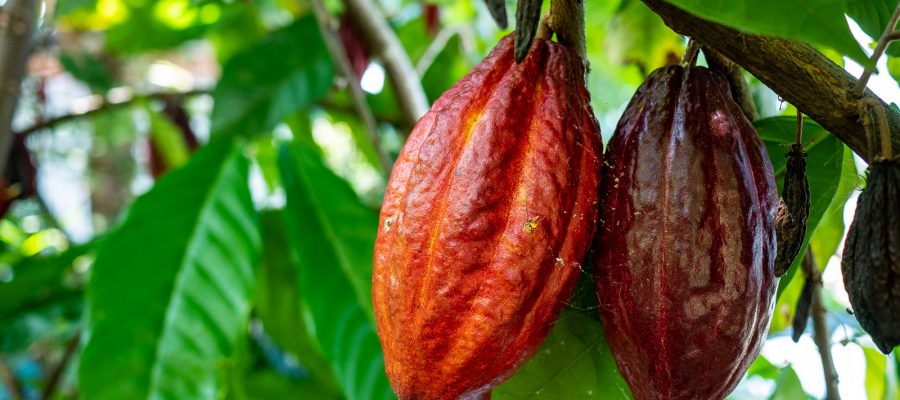Scientific Name: Theobroma cacao
Bahasa Indonesian: Cokelat
Batak: Cokelat
Basic Information:
The cocoa bean or simply cocoa, which is also called the cacao bean or cacao is the dried and fully fermented seed of Theobroma cacao, from which cocoa solids (a mixture of nonfat substances) and cocoa butter (the fat) can be extracted. Cocoa beans are the basis of chocolate, and Mesoamerican foods including tejate, a pre-Hispanic drink that also includes maize.
A cocoa pod (fruit) has a rough, leathery rind about 2 to 3 cm (0.79 to 1.18 in) thick (this varies with the origin and variety of pod) filled with sweet, mucilaginous pulp (called baba de cacao in South America) with a lemonade-like taste enclosing 30 to 50 large seeds that are fairly soft and a pale lavender to dark brownish purple color.
During harvest, the pods are opened, the seeds are kept, and the empty pods are discarded and the pulp made into juice. The seeds are placed where they can ferment. Due to heat buildup in the fermentation process, cacao beans lose most of the purplish hue and become mostly brown in color, with an adhered skin which includes the dried remains of the fruity pulp. This skin is released easily by winnowing after roasting. White seeds are found in some rare varieties, usually mixed with purples, and are considered of higher value.
Cocoa trees grow in hot, rainy tropical areas within 20° of latitude from the Equator. Cocoa harvest is not restricted to one period per year and a harvest typically occurs over several months. In fact, in many countries, cocoa can be harvested at any time of the year.
Immature cocoa pods have a variety of colours, but most often are green, red, or purple, and as they mature, their colour tends towards yellow or orange, particularly in the creases. Unlike most fruiting trees, the cacao pod grows directly from the trunk or large branch of a tree rather than from the end of a branch, similar to jackfruit. This makes harvesting by hand easier as most of the pods will not be up in the higher branches. The pods on a tree do not ripen together; harvesting needs to be done periodically through the year.
Health Benefits:
- Cacao’s antioxidant power (ORAC) is one of the very highest. Considered a ‘super food’ thanks its many wholesome qualities, it can help protect against cell ageing, tumors, and even some diseases like Alzheimer’s
- Cocoa is rich in polyphenols, which have significant health benefits, including reduced inflammation and improved cholesterol levels
- Cocoa can improve blood flow and reduce cholesterol. Eating up to one serving of chocolate per day may reduce your risk of heart attack, heart failure and stroke
- Cocoa may exert some positive effects on mood and symptoms of depression by reducing stress levels and improving calmness, contentment and overall psychological well-being
- Cocoa and dark chocolate may reduce your risk of diabetes and maintain healthy blood sugar levels
- Cocoa extract has demonstrated some anti-asthmatic properties in animal studies
Fun Facts:
- More than 4,000 years ago, it was consumed by pre-Columbian cultures along the Yucatán, including the Mayans, and as far back as Olmeca civilization in spiritual ceremonies
- Christopher Columbus is said to have brought the first cocoa beans back to Europe from his fourth visit to the New World between 1502 and 1504
- Ever watched Psycho? The blood in the famous shower scene was in fact chocolate syrup
- Today, cacao trees grow in a limited geographical zone, of about 20° to the north and south of the Equator. Nearly 70% of the world crop today is grown in West Africa
- To make 1 kg (2.2 lb) of chocolate, about 300 to 600 beans are processed, depending on the desired cocoa content
- Cocoa beans’ most noted active constituent is theobromine, a compound similar to caffeine
- Cocoa butter, also called theobroma oil, is a pale-yellow, edible vegetable fat extracted from the cocoa bean. It is used to make chocolate, as well as some ointments, toiletries, and pharmaceuticals. Cocoa butter has a cocoa flavor and aroma
- With an annual average consumption per capita of 11.5 kg, the UK is one of the largest “chocolate” consumers in the world
- Most of the chocolate sold in the UK has less than 1% of cocoa. In France it would be illegal to call it chocolate
- Amsterdam is the top cocoa port in the world and over 500,000 tons of cocoa make their way through it every day
- Indonesia is the world’s third largest producer of cacao, but many of its growers have never tasted chocolate: the seeds are usually exported before fermentation for use in industry, like cosmetics
- Cocoa/chocolate is thought be an aphrodisiac
- Cocoa beans are called “cocoa” beans and not “cacao” beans because of a spelling mistake made by English importers in the 18th century when chocolate was becoming popular.
Sources:
https://en.wikipedia.org/wiki/Cocoa_bean
https://www.healthline.com/nutrition/cocoa-powder-nutrition-benefits#section9
http://justfunfacts.com/interesting-facts-about-cocoa-beans/
https://rodellekitchen.com/resources/learning/cocoa-fun-facts/

